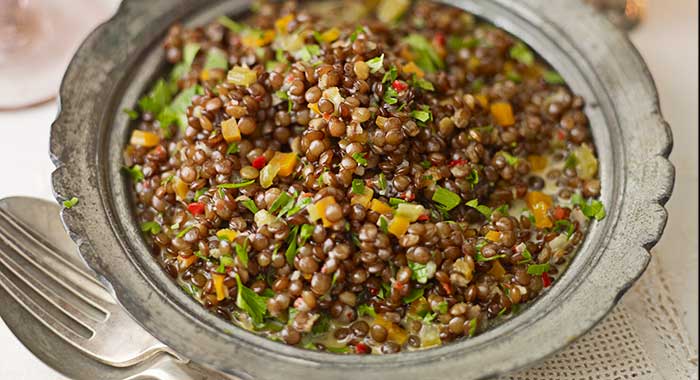
Pronounce it: len-til
The lentil plant (Lens Culinaris) originates from Asia and North Africa and is one of our oldest sources of food. A cousin to the pea and a rich provider of protein and carbohydrates the lentil is also a good source of calcium, phosphorus, iron and B vitamins – making it an important diet staple the world over.
There are several different varieties – most commonly used in cooking are Brown, Red and Green lentils, although Puy and Yellow are stocked in many health and specialist shops.
Availability
All year round.
Choose the best
Lentils can be bought, ready to eat, in a can and are ideal for adding bulk to salads and sides.
Most commonly, lentils are bought dried and ideally will be firm, clean and unshrivelled. The type of lentil you choose will depend on intended usage:
Green and brown: Ideal for warm salads, casseroles and stuffing as they tend to retain their shape after cooking.
Puy lentils: These grey-green lentils, grown in the French region of Le Puy, are often more expensive than other common cooking varieties and are thought to be superior in texture (which they retain after cooking) and taste. This makes them the perfect accompaniment to more expensive ingredients such as fish and game, as well as sausages.
Red split lentils: When cooked these lentils form a rich puree and therefore are superb for thickening dishes such as soups and casseroles. They are also often cooked with spices to make the Indian side dish, dhal.
Yellow lentils: Being quite similar to Red Split lentils, the yellow variety are used in a similar way and are great for adding colour to winter dishes.
Prepare it
Lentils do not require it but can be soaked in order to reduce cooking time by about half.
Before cooking, rinse lentils in cold water, pick over to remove debris or shrivelled lentils and then drain.
Store it
Keep lentils in an airtight container in a cool, dry place. Although lentils can be kept and eaten indefinitely, they are best enjoyed within one year of purchase.
Cook it
Boil lentils in three times more water than pulse and avoid cooking with anything acidic – such as vinegar.
Lentils will vary in their cooking times depending on their variety and age so always check the packet.
As a rough guide to cooking times:
Green and Brown lentils: 35 – 45 minutes
Red Split lentils: 15 – 20 minutes
Puy lentils: 20 – 25 minutes
Yellow lentils: 15 – 20 minutes
Be the first to comment on "Lentils"